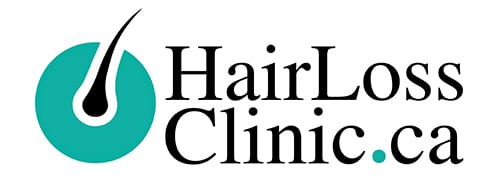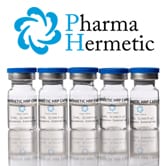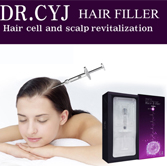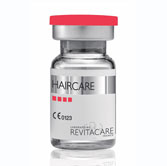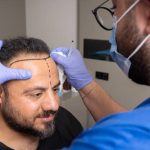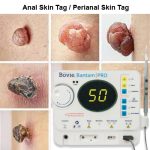
FEMALE PATTERN HAIR LOSS | CAUSE & TREATMENT | HAIR LOSS CLINIC TORONTO

FREE ONLINE HAIR LOSS ASSESSMENT FORM
Are you experiencing any hair loss or scalp issues? Get a Certified Trichologist to assess and help treat your condition in Toronto and Greater Toronto Area. Please complete our online Trichology Assessment Form to get started now.
What is Female Pattern Hair Loss?
Female pattern hair loss, also known as FPHL, female pattern baldness, or female pattern alopecia, is a type of androgenetic alopecia that affects women. Androgenetic alopecia is a genetic condition that affects both men and women. For female hair loss, the pattern of hair loss is different than that of men.
Female pattern hair loss, also known as FPHL, female pattern baldness, or female pattern alopecia, is a type of androgenetic alopecia that affects women. Androgenetic alopecia is a genetic condition that affects both men and women. For female hair loss, the pattern of hair loss is different than that of men.
Male pattern hair loss pattern looks like a horseshoe, with the frontal hairline receding into the back of the scalp. For most men, the side and back of the hairs remain intact. For female pattern hair loss, the pattern is different. Women experience a diffused hair loss all over the scalp, starting from the top of the scalp and progressively thinning throughout the entire scalp region. Androgenetic alopecia causes miniaturization of the hair.
For men, the miniaturization affects all the affected hairs in the horseshoe pattern. For women though, the miniaturization doesn’t affect all the hairs. So even though hair thinning is apparent, most women still maintains their frontal hair line unlike male pattern hair loss. The hairs produced by the affected follicles become progressively smaller in diameter, shorter in length and lighter in colour until eventually the follicles shrink completely and stop producing hair.
It is very uncommon for women to bald following the male pattern unless there is excessive production of androgens in the body. Other conditions that may cause receding hair line in women are frontal fibrosing alopecia, a scarring autoimmune disorder.
FPHL affects about 40% of women before they reach 50 years old. It is more prevalent in post-menopausal women suggesting that hormones is also a contributing cause of hair loss. Although female pattern baldness is not as common as male baldness, it is quite distressing for any women to face hair loss at any point in life.
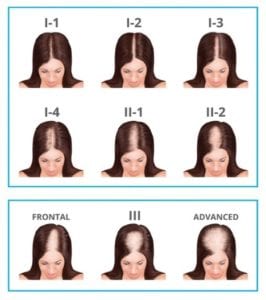
What Causes Female Pattern Hair Loss?
Genetics and hormones appear to be the main causes of female pattern hair loss. Age, environment, stress, and nutrition also play a role in FPHL. Women can inherit the gene for pattern baldness from either parent. Androgenetic hair loss is cause by hormones in both men and women. For both men and women, the specific hormone that causes hair loss is called dihydrotestosterone, or DHT. This is a hormone that your body produces as a byproduct of testosterone. Some women tend to carry genes that make hair follicles susceptible to destruction due male hormone DHT. For women, besides hereditary, imbalance of hormones caused by ovarian cysts, pregnancy, taking high androgen index birth control pills, and menopause can also cause androgenetic hair loss. After menopause, hair loss is more prevalent as the sex hormone estrogen levels drop in women.
Besides genetics / heredity and hormonal changes, other triggers may also contribute to female pattern hair loss:
- Stress
- Poor Nutrition
- Birth Control Pills
- Menopause
- Medication
- Radiation therapy
- Illnesses, such as diabetes and lupus
- Significant weight loss
What Treatment is Best for Female Pattern Hair Loss?
There is no cure for female pattern hair loss. However, treatment is advisable to help prevent further hair loss and to stimulate hair regrowth. The type of treatment recommended by your Trichologist will depend on the extent of your hair loss, in addition to other factors as mentioned above. The only Food and Drug Administration–approved medication to treat FPHL is topical minoxidil.
Hormonal Treatments
Hormones that block the effects of androgens are also often used to prevent the progression of hair loss in female pattern baldness. Some medication such as finasteride, spironolactone, cyproterone, and flutamide work as anti-androgen agents and reduce the destructive effects of androgen on hair follicles. Women in their childbearing years should not use Finasteride due to birth defects.
Nonmedical Treatments for Female Pattern Hair Loss
At the TRICHOLOGY CENTRE, more natural treatments for female pattern hair loss is preferred over hormone replacement therapy as many of them have negative side effects. We have proven hair loss treatments and nutritional counselling that can stabilizes and help with the regrowth of your hair.
Micronutrients
The role of diet and nutrition to help female pattern hair loss is growing. New evidenced-based recommendations that micronutrients including certain vitamins and minerals have shown positive results. Micronutrients can reduce oxidative stress, an increasingly suspected contributor to female pattern hair loss. Vitamin D for example, have shown to help modify the immune response by inhibiting Th1 cell proliferation.
Vitamin D – Vitamin D boosts immunity, keeps bones strong and skin healthy, stimulates cell growth, and helps create new hair follicles. Vitamin D deficiency has been linked to alopecia areata.
Biotin – Biotin is an important coenzyme for carboxylation reactions. Biotin deficiency has been shown to cause hair loss.
Zinc – Zinc is an essential mineral upon which hundreds of enzymes depend for their catalytic activity
Iron or ferritin – Iron deficiency remains the most common nutritional deficiency in the world, a sign of which includes chronic diffuse telogen hair loss.
Vitamin A or retinoid or retinol – Vitamin A is an essential vitamin for hair follicles. It also helps skin glands make sebum. Sebum moisturizes the scalp and helps keep hair healthy.
Vitamin C – Vitamin C is a powerful antioxidant that helps protect against the oxidative stress caused by free radicals. It also helps your body absorb iron, a mineral necessary for hair growth.
Vitamin E – Like vitamin C, vitamin E is an antioxidant that can prevent oxidative stress. In one documented study, people with hair loss experienced a 34.5% increase in hair growth after supplementing with vitamin E for 8 months.
Magnesium – Magnesium acts as a cofactor for over 300 enzyme systems, and plays an important role in nucleotide synthesis, a frequent process in the rapidly dividing hair follicle.
Selenium – Selenium also contributes to antioxidant defense mechanisms via its interaction with the enzyme glutathione peroxidase.
Vitamin B12 or cobalamin – B12 contribute to nucleic acid production and thus possess an important role in the health of the hair follicles.
Folic acid or folate – Folic acid is primarily responsible for healthy cell growth including the cells in hair follicles.
Copper – copper acts with zinc in the antioxidant enzyme copper/zinc superoxide dismutase.
Adding certain vitamins and minerals can help promote hair growth and nurture the hair follicles and scalp. Speak with a certified Trichologist on the best dietary, vitamins and minerals to help you with alopecia areata.
Mesotherapy solutions for alopecia areata
Mesotherapy is a technique that uses injections of vitamins, enzymes, hormones, and plant extracts to rejuvenate the scalp and hair follicles.
AAPE® STEM CELL THERAPY
AAPE® (Adipose-derived stem cells Protein Extracts) is a mixture of refined growth factors extracted from human adipose to promote hair growth and scalp health using outstanding ingredients approved by US FDA and CFDA. AAPE has been proven to be highly effective therapy for hair regeneration. For more information abour AAPE visit Here
PHARMA HERMETIC HAIR RECOVERY PROGRAM®
Pharma Hermetic Hair Recovery Program® works at revitalizing the hair bulb and obtaining a greater thickness and strength. It helps strengthen the anchorage of the root, and rebalance the scalp.
In addition, the Hair Recovery Program® SP55, enhance the growth of new hair and activates dormant follicles thanks to its effective active ingredients. Providing all the necessary nutrients to repair the weakened and brittle hair. After the treatment, the hair becomes thicker and more voluminous.
We rely on ingredients suitable to penetrate the scalp and stop hair loss.
- Thicker hair.
- More density.
- No side effect.
- Topical application.
- Lasting results.
For more information about Pharma Hermetic CLICK HERE
NOURKRIN® WOMAN HAIR LOSS
If you’re worried about certain hair loss medications that contain ingredients that may cause some side effects such as Minoxidil, we offer a hair loss treatment called Nourkrin®. Nourkrin® contains natural ingredients and has been clinically proven to help thinning hair. The key active ingredients are marine-based extracts of proteins and polysaccharides that have been combined with silica, vitamin C, and horsetail extract. Developed by scientists in Finland, Nourkrin® has been the subject of many double blind, placebo-controlled clinical studies, the latest of which showed that 77% of all participants reported a positive effect during a six-month treatment period and their hair count increased by an average of 35.7%. For more information CLICK HERE
THERADOME® LASER HAIR THERAPY
The Theradome® brings you the world’s most advanced laser hair growth treatment to enjoy from the comfort of your own home. Unlike Light Emitting Diodes (LEDs) devices, our laser light targets the stem cells at the base of hair follicles. This allows the formation of a new photonic pathway that can restore hair to a healthy state. Theradome® one-of-a-kind laser hair helmet was engineered based on four crucial scientific criteria, which together provide the most powerful and efficacious laser hair growth treatment available. For more information about Theradome®, please visit Here
Cosmetic Solutions For Female Pattern Hair Loss
SMP Scalp Micropigmentation is a popular cosmetic solution for female pattern hair loss. If your condition persist and hair is not growing back fully, you may consider SMP to camouflage the bald spots. SMP, commonly known as hair tattoo, the technique of placing individual pigment tattoo to replicate the appearance of real hair follicles. For more information about scalp micropigmentation, please visit Here

FIND A TRICHOLOGIST IN TORONTO GTA
With the numerous available treatments for alopecia areata our Trichologist can recommend the best treatment that can help with alopecia areata. At Trichology Centre, we have helped patients with alopecia areata, advising them the best treatments available and helping them regain their confidence and self-esteem. Early assessment and treatment from the onset of hair loss is important and can help prevent the condition to worsen.
We have two clinics in the Toronto GTA,
TRICHOLOGY CENTRE | hairlossclinic.ca | hairtattoo.ca | laserhairtherapy.ca
225 Wellesley St E, Toronto
9140 Leslie St, Richmond Hill.
Please give us a call at 647-492-9093
ADDRESS
Toronto, 225 Wellesley St East #5
Richmond Hill, 9140 Leslie St #301
PHONE
(647) 492-9093
hairlossclinic.ca@gmail.com
WORKING HOURS
Mon-Sat 10:30 am - 8:00 pm
Sunday CLOSED
Comments are closed.
